

Compact Muon Solenoid
LHC, CERN
| CMS-TOP-20-002 ; CERN-EP-2021-131 | ||
| Observation of tW production in the single-lepton channel in pp collisions at $\sqrt{s} = $ 13 TeV | ||
| CMS Collaboration | ||
| 3 September 2021 | ||
| JHEP 11 (2021) 111 | ||
| Abstract: A measurement of the cross section of the associated production of a single top quark and a W boson in final states with a muon or electron and jets in proton-proton collisions at $\sqrt{s} = $ 13 TeV is presented. The data correspond to an integrated luminosity of 36 fb$^{-1}$ collected with the CMS detector at the CERN LHC in 2016. A boosted decision tree is used to separate the tW signal from the dominant $\mathrm{t\bar{t}}$ background, whilst the subleading W+jets and multijet backgrounds are constrained using data-based estimates. This result is the first observation of the tW process in final states containing a muon or electron and jets, with a significance exceeding 5 standard deviations. The cross section is determined to be 89 $\pm$ 4 (stat) $\pm$ 12 (syst) pb, consistent with the standard model. | ||
| Links: e-print arXiv:2109.01706 [hep-ex] (PDF) ; CDS record ; inSPIRE record ; HepData record ; CADI line (restricted) ; | ||
| Figures | |

png pdf |
Figure 1:
Leading-order Feynman diagrams for single top quark production in the tW channel. Charge conjugate states are implied. |

png pdf |
Figure 1-a:
Leading-order Feynman diagram for single top quark production in the tW channel. Charge conjugate states are implied. |

png pdf |
Figure 1-b:
Leading-order Feynman diagram for single top quark production in the tW channel. Charge conjugate states are implied. |

png pdf |
Figure 2:
Feynman diagrams for tW single top quark production at next-to-leading order that are removed from the signal definition in the DR scheme. Charge conjugate states are implied. |

png pdf |
Figure 2-a:
Feynman diagram for tW single top quark production at next-to-leading order that are removed from the signal definition in the DR scheme. Charge conjugate states are implied. |

png pdf |
Figure 2-b:
Feynman diagram for tW single top quark production at next-to-leading order that are removed from the signal definition in the DR scheme. Charge conjugate states are implied. |
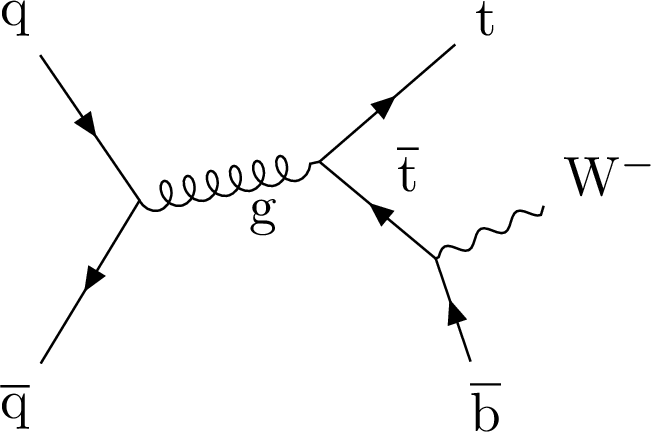
png pdf |
Figure 2-c:
Feynman diagram for tW single top quark production at next-to-leading order that are removed from the signal definition in the DR scheme. Charge conjugate states are implied. |
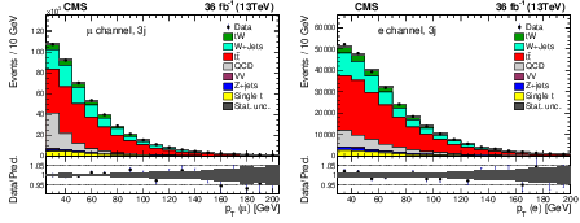
png pdf |
Figure 3:
The ${p_{\mathrm {T}}}$ of the selected muon (left) and electron (right) in the signal region of their respective channels. The signal and backgrounds have been scaled with the results of the final fit. The lower panel shows the ratio of observed data to the prediction for signal and background. In both panels the hatched regions show the statistical uncertainty from the limited size of the simulated samples for each bin. |

png pdf |
Figure 3-a:
The ${p_{\mathrm {T}}}$ of the selected muon in the corresponding signal region. The signal and backgrounds have been scaled with the results of the final fit. The lower panel shows the ratio of observed data to the prediction for signal and background. In both panels the hatched regions show the statistical uncertainty from the limited size of the simulated samples for each bin. |
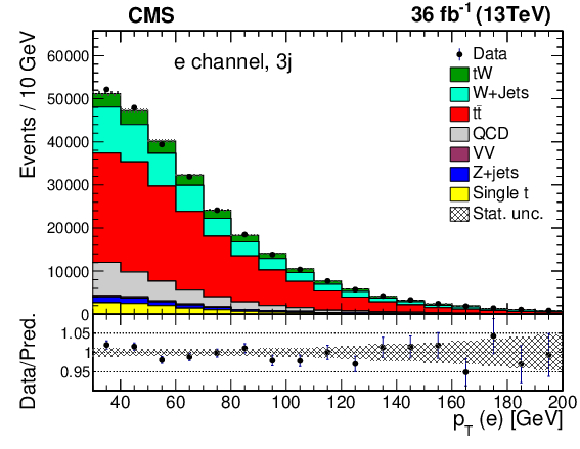
png pdf |
Figure 3-b:
The ${p_{\mathrm {T}}}$ of the selected electron in the corresponding signal region. The signal and backgrounds have been scaled with the results of the final fit. The lower panel shows the ratio of observed data to the prediction for signal and background. In both panels the hatched regions show the statistical uncertainty from the limited size of the simulated samples for each bin. |

png pdf |
Figure 4:
BDT discriminant in the signal region for the muon (left) and electron (right) channels for the (from upper to lower) 3j, 2j and 4j regions. The upper 3j region is considered the nominal signal region, while the remaining 2j and 4j regions are considered control regions, enhanced in W+jets and QCD multijet, and ${\mathrm{t} {}\mathrm{\bar{t}}}$ background events, respectively. The shape of the discriminant for the tW signal multiplied by 10 is overlayed. The signal and backgrounds have been scaled with the results of the fit. The lower panel shows the ratio of observed data to the prediction for signal and background. In both panels the hatched regions show the total uncertainty of the prediction. |
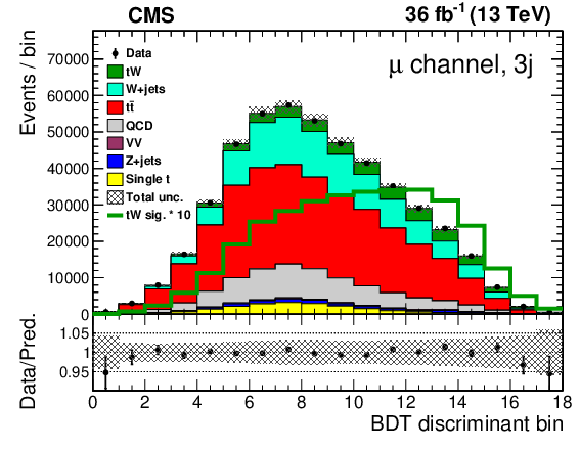
png pdf |
Figure 4-a:
BDT discriminant in the signal region for the muon channel for the 3j region. The 3j region is considered the nominal signal. The shape of the discriminant for the tW signal multiplied by 10 is overlayed. The signal and backgrounds have been scaled with the results of the fit. The lower panel shows the ratio of observed data to the prediction for signal and background. In both panels the hatched regions show the total uncertainty of the prediction. |
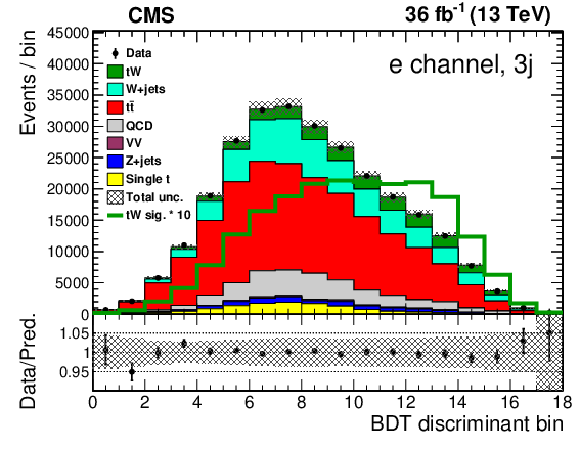
png pdf |
Figure 4-b:
BDT discriminant in the signal region for the electron channel for the 3j region. The 3j region is considered the nominal signal. The shape of the discriminant for the tW signal multiplied by 10 is overlayed. The signal and backgrounds have been scaled with the results of the fit. The lower panel shows the ratio of observed data to the prediction for signal and background. In both panels the hatched regions show the total uncertainty of the prediction. |
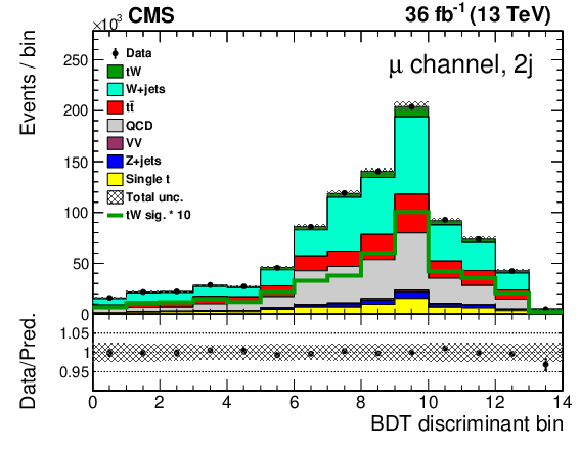
png pdf |
Figure 4-c:
BDT discriminant in the signal region for the muon channel for the 2j region. The 2j region is considered a control region, enhanced in W+jets and QCD multijet. The shape of the discriminant for the tW signal multiplied by 10 is overlayed. The signal and backgrounds have been scaled with the results of the fit. The lower panel shows the ratio of observed data to the prediction for signal and background. In both panels the hatched regions show the total uncertainty of the prediction. |

png pdf |
Figure 4-d:
BDT discriminant in the signal region for the electron channel for the 2j region. The 2j region is considered a control region, enhanced in W+jets and QCD multijet. The shape of the discriminant for the tW signal multiplied by 10 is overlayed. The signal and backgrounds have been scaled with the results of the fit. The lower panel shows the ratio of observed data to the prediction for signal and background. In both panels the hatched regions show the total uncertainty of the prediction. |
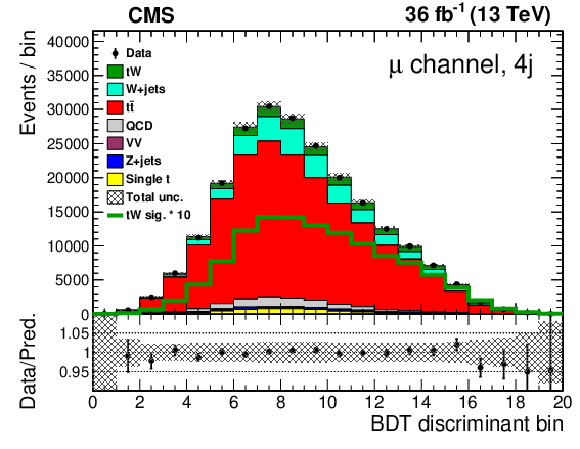
png pdf |
Figure 4-e:
BDT discriminant in the signal region for the muon channel for the 4j region. The 4j region is considered a control region, enhanced in ${\mathrm{t} {}\mathrm{\bar{t}}}$ background events. The shape of the discriminant for the tW signal multiplied by 10 is overlayed. The signal and backgrounds have been scaled with the results of the fit. The lower panel shows the ratio of observed data to the prediction for signal and background. In both panels the hatched regions show the total uncertainty of the prediction. |
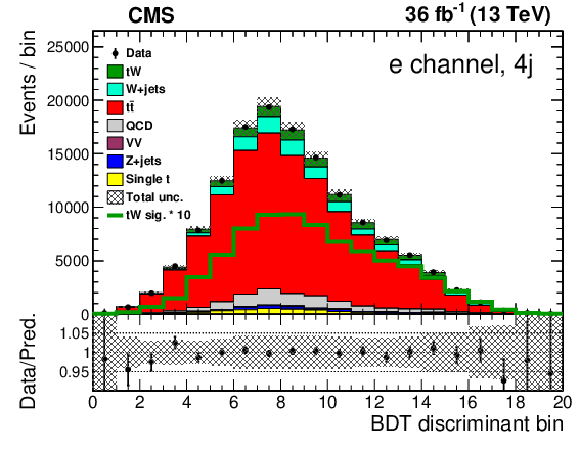
png pdf |
Figure 4-f:
BDT discriminant in the signal region for the electron channel for the 4j region. The 4j region is considered a control region, enhanced in ${\mathrm{t} {}\mathrm{\bar{t}}}$ background events. The shape of the discriminant for the tW signal multiplied by 10 is overlayed. The signal and backgrounds have been scaled with the results of the fit. The lower panel shows the ratio of observed data to the prediction for signal and background. In both panels the hatched regions show the total uncertainty of the prediction. |
| Tables | |
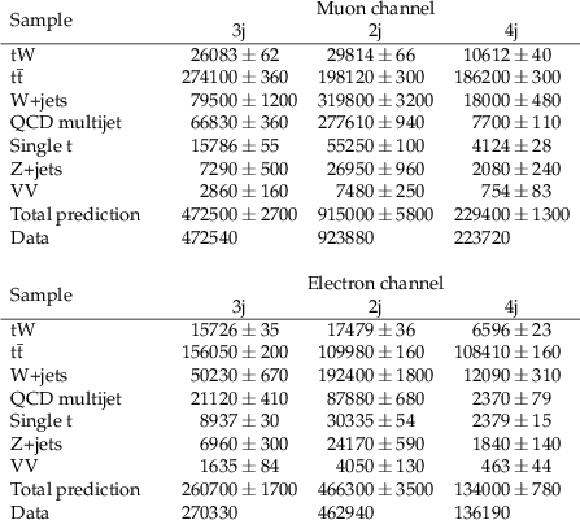
png pdf |
Table 1:
The total number of events passing event selection in each analysis region and their associated statistical uncertainties. The event yields are given for the tW signal and all major backgrounds for both the muon (upper) and electron (lower) channels. The estimation of the QCD multijet background comes from a data-based method, whilst the W+jets background is estimated from simulation and corrected using data. All other processes are estimated from simulation only. The single t background is comprised of the $t$- and $s$-channel single top quark processes. |
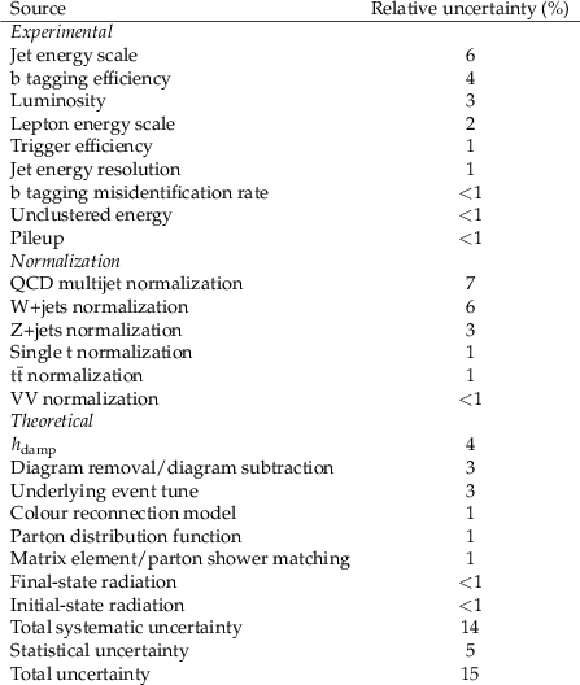
png pdf |
Table 2:
Relative uncertainty in the measured cross section from each source of systematic uncertainty for the combination of the muon and electron channels. The table is divided into experimental, normalization, and theoretical uncertainties. Uncertainties arising from the limited size of the simulated samples are included in the statistical uncertainty. |
| Summary |
|
The first observation of the associated production of a single top quark and a W boson in the single-lepton channel containing a muon or electron and jets is presented. The cross section is extracted using a binned likelihood fit of the discriminant from a boosted decision tree designed to separate the signal from the dominant top quark and antiquark pair background. The analysis is performed using proton-proton collision data at a centre-of-mass energy of 13 TeV recorded by the CMS detector at the LHC corresponding to an integrated luminosity of 36 fb$^{-1}$. The cross section is 89 $\pm$ 4 (stat) $\pm$ 12 (syst) pb, with a significance exceeding 5 standard deviations, which is compatible with both the standard model predictions at approximate next-to-next-to-leading order in quantum chromodynamics of 71.7 $\pm$ 1.8 (scale) $\pm$ 3.4 (PDF) pb and at approximate next-to-next-to-next-to-leading order of 79.5$^{+1.9}_{-1.8}$ (scale)$^{+2.0}_{-1.4}$ (PDF) pb. |
| References | ||||
| 1 | T. M. P. Tait and C. P. Yuan | Single top quark production as a window to physics beyond the standard model | PRD 63 (2000) 014018 | hep-ph/0007298 |
| 2 | Q.-H. Cao, J. Wudka, and C. P. Yuan | Search for new physics via single top production at the LHC | PLB 658 (2007) 50 | 0704.2809 |
| 3 | D0 Collaboration | Observation of single top-quark production | PRL 103 (2009) 092001 | 0903.0850 |
| 4 | CDF Collaboration | Observation of electroweak single top-quark production | PRL 103 (2009) 092002 | 0903.0885 |
| 5 | ATLAS Collaboration | Evidence for the associated production of a $ \mathrm{W} $ boson and a top quark in ATLAS at $ \sqrt{s}= $ 7 TeV | PLB 716 (2012) 142 | 1205.5764 |
| 6 | CMS Collaboration | Evidence for associated production of a single top quark and $ \mathrm{W} $ boson in $ pp $ collisions at $ \sqrt{s} = $ 7 TeV | PRL 110 (2013) 022003 | CMS-TOP-11-022 1209.3489 |
| 7 | CMS Collaboration | Observation of the associated production of a single top quark and a $ \mathrm{W} $ boson in $ pp $ collisions at $ \sqrt{s} = $ 8 TeV | PRL 112 (2014) 231802 | CMS-TOP-12-040 1401.2942 |
| 8 | ATLAS Collaboration | Measurement of the production cross-section of a single top quark in association with a $ \mathrm{W} $ boson at 8 TeV with the ATLAS experiment | JHEP 01 (2016) 064 | 1510.03752 |
| 9 | ATLAS Collaboration | Measurement of the cross-section for producing a $ \mathrm{W} $ boson in association with a single top quark in $ pp $ collisions at $ \sqrt{s}= $ 13 TeV with ATLAS | JHEP 01 (2018) 063 | 1612.07231 |
| 10 | ATLAS Collaboration | Measurement of differential cross-sections of a single top quark produced in association with a $ \mathrm{W} $ boson at $ \sqrt{s}= $ 13 TeV with ATLAS | EPJC 78 (2018) 186 | 1712.01602 |
| 11 | CMS Collaboration | Measurement of the production cross section for single top quarks in association with $ \mathrm{W} $ bosons in proton-proton collisions at $ \sqrt{s}= $ 13 TeV | JHEP 10 (2018) 117 | CMS-TOP-17-018 1805.07399 |
| 12 | N. Kidonakis | Theoretical results for electroweak-boson and single-top production | PoS DIS2015 (2015) 170 | 1506.04072 |
| 13 | N. Kidonakis and N. Yamanaka | Higher-order corrections for tW production at high-energy hadron colliders | JHEP 05 (2021) 278 | 2102.11300 |
| 14 | A. S. Belyaev, E. E. Boos, and L. V. Dudko | Single top quark at future hadron colliders: Complete signal and background study | PRD 59 (1999) 075001 | hep-ph/9806332 |
| 15 | C. D. White, S. Frixione, E. Laenen, and F. Maltoni | Isolating Wt production at the LHC | JHEP 11 (2009) 074 | 0908.0631 |
| 16 | S. Frixione et al. | Single-top hadroproduction in association with a $ \mathrm{W} $ boson | JHEP 07 (2008) 029 | 0805.3067 |
| 17 | T. M. P. Tait | $ \mathrm{t}\mathrm{W}^{-} $ mode of single top production | PRD 61 (1999) 034001 | hep-ph/9909352 |
| 18 | ATLAS Collaboration | Measurement of single top-quark production in association with a $ \mathrm{W} $ boson in the single-lepton channel at $ \sqrt{s} = $ 8 TeV with the ATLAS detector | Submitted to EPJC | 2007.01554 |
| 19 | CMS Collaboration | HEPData record for this analysis | HEPData record for this analysis | |
| 20 | M. Cacciari, G. P. Salam, and G. Soyez | The anti-$ {k_{\mathrm{T}}} $ jet clustering algorithm | JHEP 04 (2008) 063 | 0802.1189 |
| 21 | M. Cacciari, G. P. Salam, and G. Soyez | FastJet user manual | EPJC 72 (2012) 1896 | 1111.6097 |
| 22 | CMS Collaboration | Particle-flow reconstruction and global event description with the CMS detector | JINST 12 (2017) P10003 | CMS-PRF-14-001 1706.04965 |
| 23 | CMS Collaboration | Performance of the CMS muon detector and muon reconstruction with proton-proton collisions at $ \sqrt{s}= $ 13 TeV | JINST 13 (2018) P06015 | CMS-MUO-16-001 1804.04528 |
| 24 | CMS Collaboration | Performance of missing transverse momentum reconstruction in proton-proton collisions at $ \sqrt{s} = $ 13 TeV using the CMS detector | JINST 14 (2019) P07004 | CMS-JME-17-001 1903.06078 |
| 25 | CMS Collaboration | The CMS experiment at the CERN LHC | JINST 3 (2008) S08004 | CMS-00-001 |
| 26 | CMS Collaboration | CMS luminosity measurements for the 2016 data taking period | CMS-PAS-LUM-17-001 | CMS-PAS-LUM-17-001 |
| 27 | E. Re | Single-top Wt-channel production matched with parton showers using the POWHEG method | EPJC 71 (2011) 1547 | 1009.2450 |
| 28 | T. Sjostrand et al. | An introduction to PYTHIA 8.2 | CPC 191 (2015) 159 | 1410.3012 |
| 29 | CMS Collaboration | Event generator tunes obtained from underlying event and multiparton scattering measurements | EPJC 76 (2016) 155 | CMS-GEN-14-001 1512.00815 |
| 30 | S. Alioli, P. Nason, C. Oleari, and E. Re | A general framework for implementing NLO calculations in shower Monte Carlo programs: the POWHEG BOX | JHEP 06 (2010) 043 | 1002.2581 |
| 31 | P. Skands, S. Carrazza, and J. Rojo | Tuning PYTHIA 8.1: the Monash 2013 Tune | EPJC 74 (2014) 3024 | 1404.5630 |
| 32 | J. Alwall et al. | The automated computation of tree-level and next-to-leading order differential cross sections, and their matching to parton shower simulations | JHEP 07 (2014) 079 | 1405.0301 |
| 33 | R. Frederix and S. Frixione | Merging meets matching in MC@NLO | JHEP 12 (2012) 061 | 1209.6215 |
| 34 | P. Artoisenet, R. Frederix, O. Mattelaer, and R. Rietkerk | Automatic spin-entangled decays of heavy resonances in Monte Carlo simulations | JHEP 03 (2013) 015 | 1212.3460 |
| 35 | J. Alwall et al. | Comparative study of various algorithms for the merging of parton showers and matrix elements in hadronic collisions | EPJC 53 (2008) 473 | 0706.2569 |
| 36 | NNPDF Collaboration | Parton distributions with LHC data | NPB 867 (2013) 244 | 1207.1303 |
| 37 | GEANT4 Collaboration | GEANT4--a simulation toolkit | NIMA 506 (2003) 250 | |
| 38 | J. Allison et al. | GEANT4 developments and applications | IEEE Trans. Nucl. Sci. 53 (2006) 270 | |
| 39 | CMS Collaboration | Performance of the CMS Level-1 trigger in proton-proton collisions at $ \sqrt{s} = $ 13 TeV | JINST 15 (2020) P10017 | CMS-TRG-17-001 2006.10165 |
| 40 | CMS Collaboration | The CMS trigger system | JINST 12 (2017) P01020 | CMS-TRG-12-001 1609.02366 |
| 41 | CMS Collaboration | Performance of electron reconstruction and selection with the CMS detector in proton-proton collisions at $ \sqrt{s} = $ 8 TeV | JINST 10 (2015) P06005 | CMS-EGM-13-001 1502.02701 |
| 42 | CMS Collaboration | Jet energy scale and resolution in the CMS experiment in $ pp $ collisions at 8 tev | JINST 12 (2017) P02014 | CMS-JME-13-004 1607.03663 |
| 43 | CMS Collaboration | Identification of heavy-flavour jets with the CMS detector in $ pp $ collisions at 13 TeV | JINST 13 (2018) P05011 | CMS-BTV-16-002 1712.07158 |
| 44 | CMS Collaboration | Measurement of the inelastic proton-proton cross section at $ \sqrt{s}= $ 13 TeV | JHEP 07 (2018) 161 | CMS-FSQ-15-005 1802.02613 |
| 45 | CMS Collaboration | Jet algorithms performance in 13 TeV data | CMS-PAS-JME-16-003 | CMS-PAS-JME-16-003 |
| 46 | CMS Collaboration | Measurement of the $ \mathrm{t\bar{t}} $ production cross section, the top quark mass, and the strong coupling constant using dilepton events in $ pp $ collisions at $ \sqrt{s}= $ 13 TeV | EPJC 79 (2019) 368 | CMS-TOP-17-001 1812.10505 |
| 47 | CMS Collaboration | Cross section measurement of $ t $-channel single top quark production in $ pp $ collisions at $ \sqrt{s}= $ 13 TeV | PLB 772 (2017) 752 | 1711.01769 |
| 48 | S. Catani, D. de Florian, M. Grazzini, and P. Nason | Soft-gluon resummation for Higgs boson production at hadron colliders | JHEP 07 (2003) 028 | hep-ph/0306211 |
| 49 | CMS Collaboration | Extraction and validation of a new set of CMS PYTHIA8 tunes from underlying-event measurements | EPJC 80 (2020) 4 | CMS-GEN-17-001 1903.12179 |
| 50 | S. Argyropoulos and T. Sjostrand | Effects of color reconnection on $ \mathrm{t\bar{t}} $ final states at the LHC | JHEP 11 (2014) 043 | 1407.6653 |
| 51 | J. R. Christiansen and P. Z. Skands | String formation beyond leading colour | JHEP 08 (2015) 003 | 1505.01681 |
| 52 | NNPDF Collaboration | Parton distributions for the LHC Run II | JHEP 04 (2015) 040 | 1410.8849 |

|
Compact Muon Solenoid LHC, CERN |

|

|

|

|

|

|